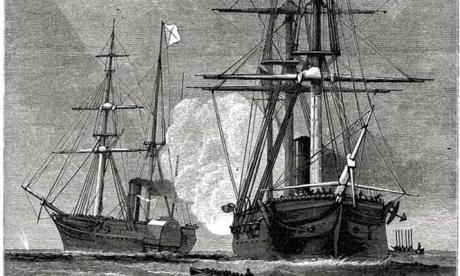The ''Trent'' Affair
- American Civil War
- 5 mins
By Crusader1307
Most know of the terrible period of American History known as The War Between The States. Occurring between the years 1861 and 1865, The War pitted Brother against Brother, Father against Son and Belief against Belief. The majority of The World stayed out of The Conflict (at least tacitly), but one Event almost propelled The United States of America into an additional Conflict with Great Britain. Such an Event would have no doubt enlarged The Civil War into a Global Conflict. This was The “Trent” Affair.
BACKGROUND:
The major goal of The recently formed Confederate States of America was to be recognized as a Nation. To The Confederacy’s mindset, they – like their Forefathers who fought against Great Britain, they were seeking Independence from their perception of “Northern Aggression”. A quickly formed Diplomatic Corps (made up of ex-US Foreign Policy Experts), were rushed to Europe. Each approached a Major Foreign Power. Most were sympathetic, but wary of upsetting The United States Government. The US was not unaware of The South’s diplomatic moves. Reminding European Powers that this was an “Internal Affair”, most honored The US request. However, a major point The South pressed was Cotton. A major blight of Cotton and related Textiles in Europe, had greatly cut the supply of the much needed materials. The South (as early as the mid-1850s), had made Millions of USD in selling vast “Bumper Crops” as a result. Europe would no doubt end The War (by breaking The Federal Naval Blockade of The South), thus allowing vital Imports and Exports both in and out of a struggling South.
But in this, The South crippled their initial attempts. Selling off so much excess, gave many European Warehouses a Reserve which would well last into 1870. This caused many Countries to hesitate recognition. England and France however, were not unmindful of the benefits of recognition. Both harbored secret grudges against The United States, and both wished for their former “Colonial” influences in America. Queen Victoria of England and Napoleon III of France gave “Belligerent” Status to The Confederacy (much to the annoyance of The US). In this diplomatic move, The Confederacy could do “business” in Foreign Ports (IF they could get through The Naval Blockade on their own). It was a first “step”, but not enough. Into this “Arena”, two seasoned Confederate Diplomatic entered. Messers John Slidell and James Mason. Their Mission was simple. Board a Confederate Blockade Runner (Ship) and make their way to the neutral Port of Havana, Cuba. From there, they would board a British Flagged Vessel and make their way to England (and France). Both knew that they would only be able to unofficially push for “audience” with England’s and France’s Prime Ministers. They set sail in November of 1861.
“MARITIME LAW OR ACT OF WAR?”:
Acting on intelligence, The Federal Warship USS “San Jacinto”, was searching for Ships which may be attempting to transport Confederate Diplomats to Europe. Suspecting The Royal Mail Ship “Trent” to be one, “San Jacinto” crossed her bow in The Atlantic. Ordering her to “heave to”, The “Trent” Captain refused. He was clearly flying The Union Jack of England. The “San Jacinto” (who would later cite that The “Trent” was carrying “contraband”), fired a cannon shot across the bow of The “Trent”. In addition to mail, the Ship carried Passengers. The Captain of The “Trent” stopped his Vessel. A US Boarding Party approached and (after a tense period in which The British Crew armed themselves), allowed The US Sailors to board. The Captain of The “San Jacinto” demanded any Confederate Citizens be surrendered. The “Trent” Captain refused. Muskets and Cutlass were raised. However, fearing for The Crew and Passengers, Slidell and Mason made their presence known and surrendered to The US Crew (who promptly took them into custody). Taken back to The US, both were immediately incarcerated.
“APOLOGY OR WAR”:
With formal Protest filed in Liverpool by The “Trent” Captain, Parliament (predictably) was outraged. Newspapers flooded The British People with the “illegal affair”, in which a British flagged Ship was first fired upon and then boarded. Prime Minister Lord Henry Palmerston (spurred by Parliamentarian “Warhawks”), feared War with The United States. He requested a formal apology from The Lincoln Government and the release of the two Southern Diplomats. The United States refused. Palmerston had no choice. With tacit approval by Queen Victoria, 20,000 Royal British Soldiers and Marines were deployed to Canada. Their Mission was to march on Washington, if need be. War was looming.
“ONLY ONE WAR AT A TIME”:
Historians readily debate US President Lincoln’s role in the escalation of The “Trent” Affair. Some cite that Secretary of War Edwin Stanton was the real architect of the hostilities, brought about by Great Britain’s award of Belligerent Status to The Confederacy. Others cite that upon hearing of these hostilities Imperial Russia (long annoyed by France and England’s Territorial ambitions in South America), offered a Fleet to suppress any British involvement. Lincoln, upon review of the situation stated that America needed by “One War at a Time”. Although no official apology was ever offered, Slidell and Mason were released and allowed to continue on their “Mission”. The 20,000 British Troops were sent back to England.
CONCLUSION:
Would England had actually gone to War? Some say yes. Could the Incident had evolved into a larger Global Event – quite possibly. But many in England cited that the primary issue with The Southern Confederacy was their dogged support for that “Peculiar Institution” of Slavery. This may have greatly stripped England’s “Warhawks” of their “fire for War”. In the end, Slidell and Mason would ultimately fail in achieving their goal of Southern recognition. The Civil War would continue – for 3 more bloody years.





